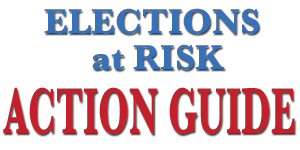AFTER The POLLS CLOSE
1. If your jurisdiction posts precinct results outside polling places, as some are required to do, photograph these for later comparison to official results.
Enlist friends to go to their local polling places and do the same. You may be able to find a list of your city or town’s polling places on the website of your elections department.
2. Observe chain of custody of ballots and memory cards.
This has a high deterrent effect. There are areas you might not be allowed into to see what is going on.
3. Central Count Election Night
You need to be able to commit to stay up all night for this. First you will watch the ballots and memory cards be brought in from the polls and go to the central tabulator. If you are fortunate, you may actually be able to see the tabulator screen. Periodically, the elections official will release results so that the press and candidates know what is happening. It is important to keep these and watch carefully for sudden changes or vote totals decreasing, which they shouldn’t. It is very important to document if vendors come in to fix things or if you notice the staff getting agitated. The computers have been known to crash or have other problems. Mostly you sit around and watch computers and bathe in the anxiety of candidates and media that want to meet a news deadline. Excellent details on Election night observing can be found in the Black Box Voting Toolkit.
4. Absentee/Vote by Mail Processing
The main steps in the process are signature verification, envelope opening, ballot unfolding and crucial sorting tasks. Signature verification can be done either electronically or manually. Although Vote by Mail election results are not be released until the polls close, state laws vary on whether or not these ballots can be counted in advance of election day. Note: Chain of custody cannot be observed or verified in a Vote by Mail system.
5. Provisional Ballot Processing
Provisional ballots are researched one by one by the elections staff. Some elections officials will not count the votes if there is any problem at all with the information on the envelope or with the envelope itself. Others will do their best to qualify as many votes as possible.
6. Rewriting of Ballots
Ballots that are determined to be unreadable by the machine due to extraneous marks or other problems are re-written on a fresh ballot. Thousands of ballots in just one county can be re-written. Observers, especially partisan observers, should watch this to confirm the accuracy of the re-write.
7. Observe Audit
This takes several days so there should be many people to do this and show up randomly to check on activities. This is supposed to be our main safeguard and it is our only chance to really see people counting votes. The DREs are particularly hard to hand tally and #4 is an important reason for doing this. Clerks and officials may try to bypass the law and make it easier on themselves to count. With no one watching, there is nothing to stop them.
8. Reconciliation Activities
What is done by the elections officials and is mandatory under the law are two different things. Not enough attention is paid here, yet this is where the rubber hits the road. A dedicated team should be in place ready to do analysis and report results as soon as they can. Computers and people that can handle large files and quantities of data are needed. Also people who are good at nitpicking details.


